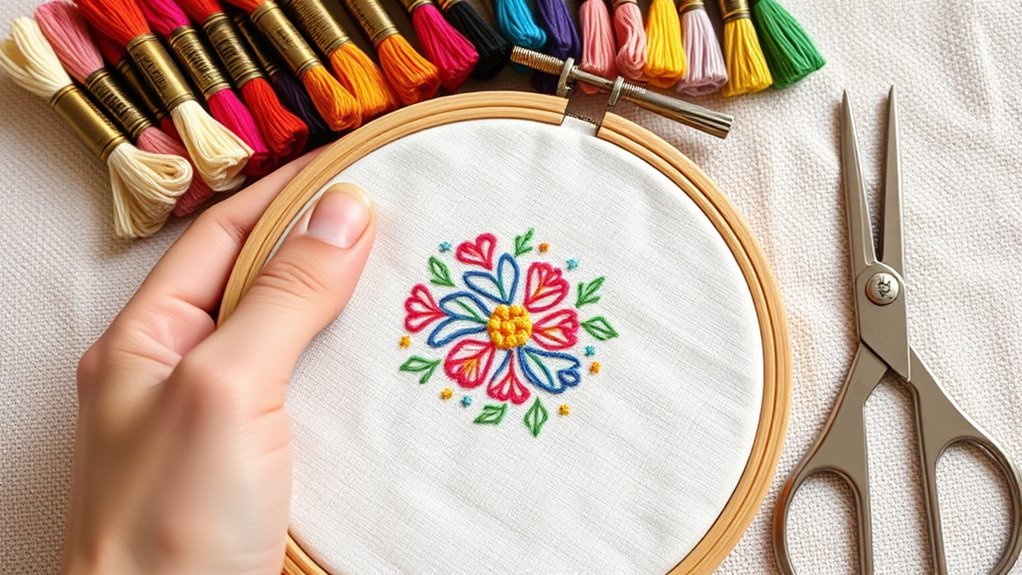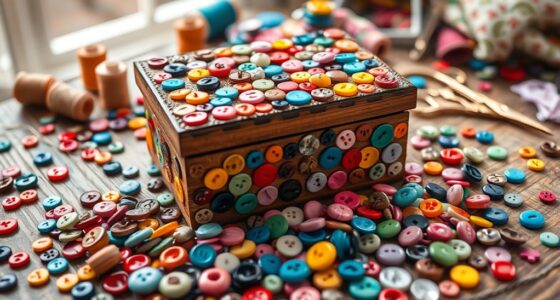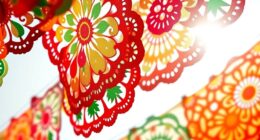To start your first embroidery project, choose quality materials like sturdy fabric and smooth floss, and gather essential tools such as needles and scissors. Begin with simple designs and basic stitches like running or backstitch to build confidence. Practice on scrap fabric first to refine your technique and troubleshoot issues early. Follow tutorials for guidance and tips. Most importantly, be patient and enjoy the process—more helpful insights await as you explore further.
Key Takeaways
- Begin with simple designs and basic stitches to build confidence and develop foundational skills.
- Choose quality materials like sturdy fabric, sharp needles, and vibrant embroidery floss for better results.
- Practice on scrap fabric to refine techniques and troubleshoot before starting your main project.
- Follow tutorials or guides to learn proper techniques, tension, and hand positioning.
- Be patient, enjoy the process, and celebrate small progress to stay motivated and reduce frustration.
Choose the Right Materials and Tools
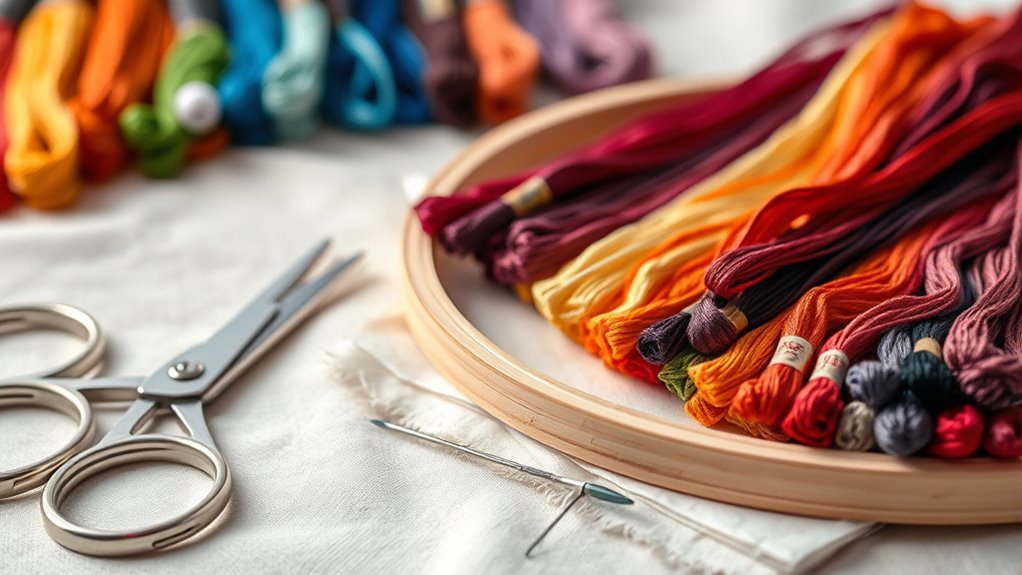
Choosing the right materials and tools is essential for successful embroidery. You want to start with quality supplies to make your project easier and more enjoyable. Pick a sturdy fabric like cotton or linen, which hold stitches well. Use sharp, high-quality needles suited for your fabric and thread thickness; this prevents frustration and broken needles. Select embroidery floss that’s smooth and vibrant, making your stitches stand out beautifully. Keep a pair of small scissors nearby for precise cuts, and gather a hoop or frame to keep your fabric taut. Having all these tools ready guarantees your work is neat and consistent. Investing in good materials from the start helps you achieve professional-looking results and boosts your confidence as you learn. Additionally, choosing quality embroidery supplies can make a significant difference in the overall outcome of your project. Ensuring that you select appropriate tools compatible with your fabric and thread will further enhance your embroidery experience. A well-chosen starter kit can also provide a convenient way to gather all necessary items and ensure they work well together. Remember that thread tension is crucial for even stitches, so selecting the right tools can help maintain consistency throughout your work.
Start With Simple Designs and Basic Stitches

Once you’ve gathered quality materials and tools, it’s best to start with simple designs that build your confidence. Choose motifs like basic shapes, initials, or small patterns that aren’t overwhelming. This allows you to focus on mastering the fundamentals without feeling frustrated. Engaging in music-making or exploring calming sound environments can also help maintain focus and reduce stress during your practice sessions. Stick to basic stitches such as running stitch, backstitch, and satin stitch; they’re easy to learn and versatile. Practicing these stitches on simple designs helps you develop steadiness and control. Keeping your projects small and manageable—a common approach in embroidery—ensures you can complete them quickly and see progress. Starting with straightforward designs also lets you refine your technique before moving on to more complex patterns. Incorporating mindfulness techniques during your embroidery sessions can further enhance concentration and enjoyment.
Practice on Scrap Fabric Before Working on Your Project
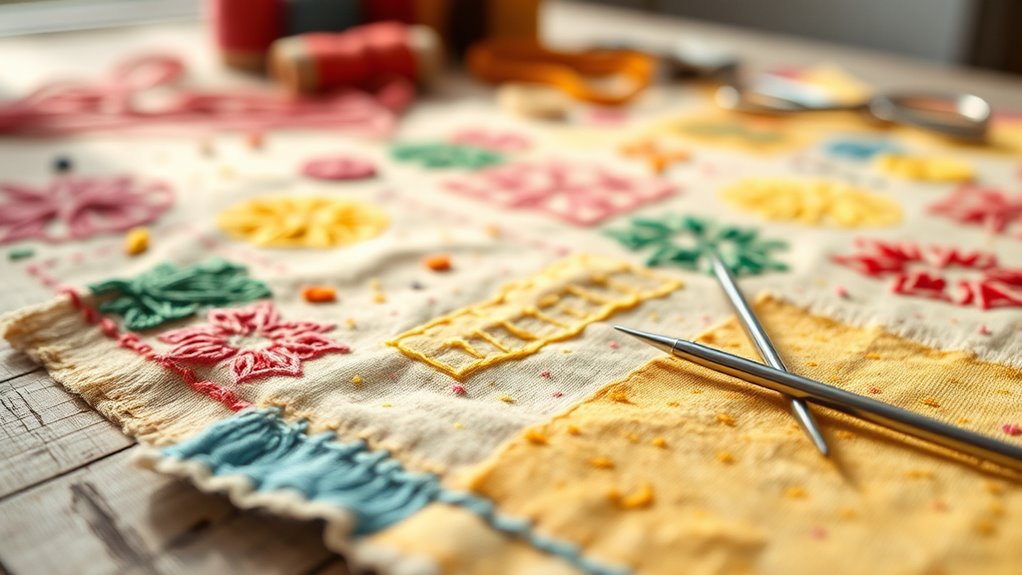
Practicing on scrap fabric before you start your final project helps you build confidence and refine your technique. It allows you to get comfortable with your chosen stitches and understand how different fabrics respond to embroidery. Additionally, testing your stitches on scrap fabric can help you evaluate the effectiveness of eye patches in a real-world setting, ensuring your final piece looks polished. Using scrap fabric to experiment with thread tension, stitch length, and spacing, so you know what works best for your project. This practice also helps you identify any issues, like skipped stitches or uneven tension, before they affect your final piece. Recognizing the scent of spoiled ground beef can help you avoid using spoiled materials that might compromise your work or safety. Being aware of cybersecurity Hack’n Jill practices can help protect your digital resources and personal information when sharing or selling your embroidery online. Incorporating knowledge of merchant services can also help in selecting the right tools and payment options if you plan to sell your embroidery work professionally. Additionally, understanding projector contrast ratios can be useful when creating visual guides or digital templates for complex embroidery designs.
Follow Tutorials and Use Guides for Technique Tips
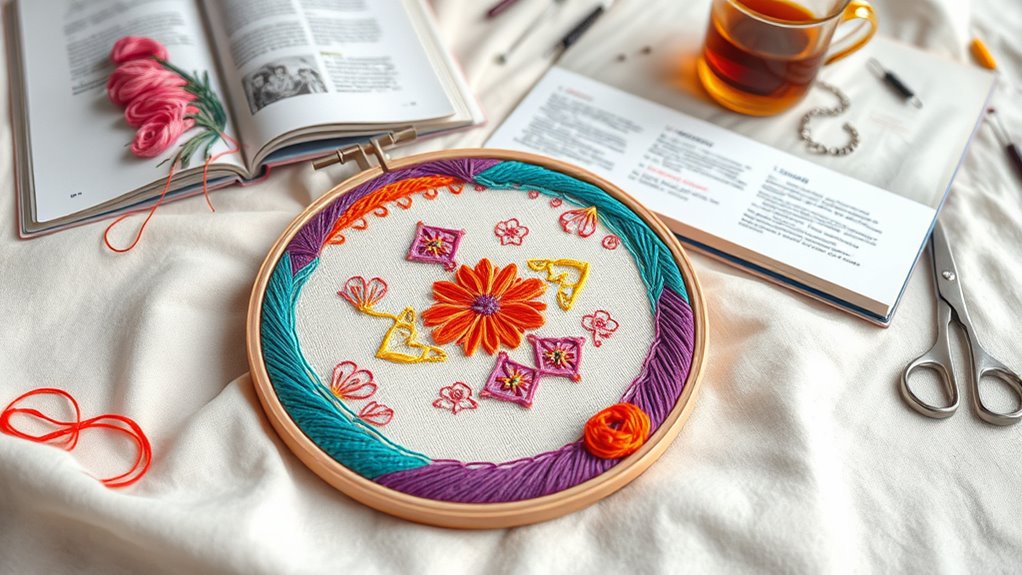
Following tutorials and using guides can substantially improve your embroidery skills. They offer clear, step-by-step instructions that help you learn new stitches and techniques quickly. Watching videos or reading detailed guides allows you to see proper hand positioning, tension, and knotting methods firsthand. This reduces mistakes and boosts your confidence as you practice. Guides often include helpful tips for choosing the right thread, fabric, and needle, ensuring your project turns out well. Additionally, proper technique is crucial for developing consistency and achieving professional-looking results. Developing a systematic approach through these resources mirrors methodical testing processes, leading to more consistent and successful embroidery projects. Incorporating technique mastery is essential to achieve neat and durable results in your embroidery work. Emphasizing creative problem-solving can help you troubleshoot and adapt techniques as needed throughout your projects. Being aware of store hours and planning your shopping trips accordingly can also help you gather supplies without last-minute stress.
Be Patient and Enjoy the Creative Process
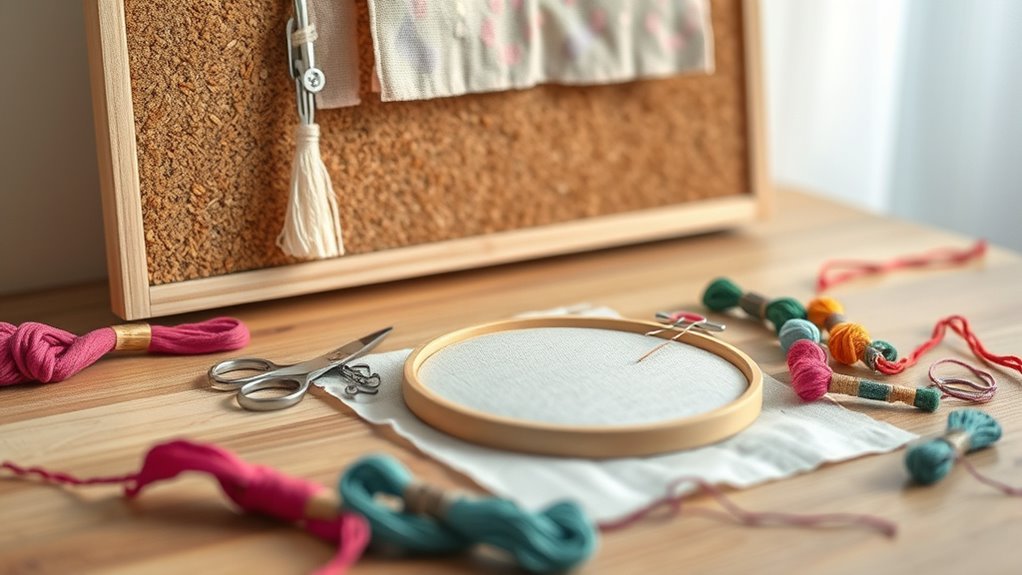
Embroidery is as much about enjoying the process as it’s about the final product. When you’re starting out, patience is key. Rushing through can lead to frustration and mistakes.
Instead, focus on these steps to make the experience rewarding:
- Take your time—don’t rush through each stitch; savor the rhythm. Incorporating mindful practices like breath awareness can enhance your concentration and enjoyment. Practicing mindfulness during embroidery can help you stay present and reduce stress. Developing a creative mindset can also boost your confidence and make the process more enjoyable.
- Celebrate small wins—finished a section? That’s progress!
- Learn from errors—mistakes are part of growth and help improve your skills.
- Remember that water-based techniques like hydrotherapy show how water can be used effectively to promote relaxation and healing, which can inspire a calming mindset during your embroidery practice.
Frequently Asked Questions
How Do I Choose the Best Embroidery Thread for My Project?
When choosing embroidery thread, you want to take into account your project’s colors and fabric type.
Opt for high-quality threads like rayon, cotton, or polyester for durability and vibrant hues.
Match the thread weight to your design’s detail; thinner threads suit intricate work, while thicker ones are better for bold stitches.
Always test a small sample first, ensuring the thread glides smoothly and complements your fabric for the best results.
What Are Common Mistakes Beginners Make in Embroidery?
When you start embroidery, you might make common mistakes like pulling threads too tight, which can cause puckering, or not securing your stitches properly, leading to unraveling.
You could also choose the wrong fabric or thread for your design, making it harder to work with.
Rushing through your stitches without planning can result in uneven work.
Take your time, practice patience, and don’t be afraid to redo sections as needed.
How Do I Choose the Right Fabric for My Design?
When choosing the right fabric for your design, consider its texture and durability. You want a fabric that’s smooth and even, like cotton or linen, which makes stitching easier.
Think about your project’s purpose too—if it’s for a detailed design, opt for a tightly woven fabric. Avoid stretchy or very loose fabrics, as they can distort your work.
Pick a fabric that matches your skill level and project goals.
What Are Troubleshooting Tips for Skipped or Uneven Stitches?
When you encounter skipped or uneven stitches, first check your thread tension—tighten or loosen as needed.
Make sure your needle is sharp and suitable for your fabric, and that it’s properly threaded.
Also, verify your machine’s settings are correct for your stitch type.
If issues persist, clean your machine to remove lint or debris, and test on scrap fabric to troubleshoot further.
How Can I Properly Store Embroidery Supplies Between Projects?
To keep your embroidery supplies organized, you should store threads in clear, labeled containers so you can easily find the colors you need.
Keep needles in a pincushion or magnetic holder to prevent losing them.
Place fabrics in flat, labeled boxes to avoid wrinkles.
Maintain scissors in a safe, accessible spot.
Regularly tidy your supplies, separating used from new, so your workspace stays neat and ready for your next beautiful project.
Conclusion
Embroidery is a journey where each stitch weaves your story into fabric. Embrace patience as your guiding thread, and let your creativity blossom like a vibrant flower. Remember, every mistake is a knot that adds character, and persistence turns a simple needle into a key that unlocks endless possibilities. With time, your project becomes a tapestry of your passion, reminding you that the true beauty lies in the process, not just the finished piece.
